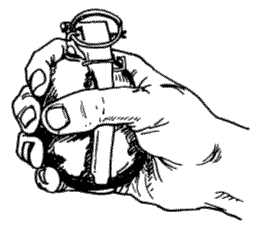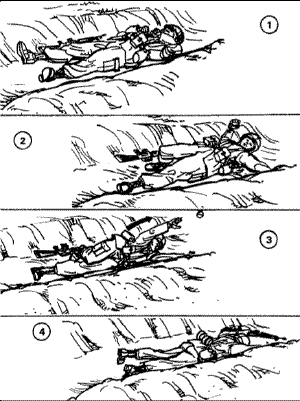Hand Grenade
|
They are used at short range and the effective casualty radius is relatively small. The built-in, delayed fuse delay allows you to safely throw it and seek cover before it explodes. There are four basic types of hand grenades, Fragmentation, Illumination, Chemical, and Incendiary. The "Safety Pin" holds the "Safety Lever" in place. Unless you hold the "Safety Lever" down with your hand, removal of the "Safety Pin" allows the "Safety Lever" to spring away from body of the grenade. This action starts the fuse (varying from a few seconds to no seconds) which then sets off the grenade.
To Secure a Grenade:
Things to Know about Specific Grenades: ABC-M7A2 and the ABC-M7A3 Riot Control Hand Grenades ABC-M25A2 Riot Control Hand Grenade AN-M14 TH3 Incendiary Hand Grenade |
From Operational Medicine 2001: Health Care in Military Settings
CAPT Michael John Hughey, MC, USNR
NAVMED P-5139
January 1, 2001
Bureau of Medicine and Surgery, Department of
the Navy, 2300 E Street NW, Washington, D.C, 20372-5300
United States Special Operations Command, 7701 Tampa Point Blvd., MacDill
AFB, Florida, 33621-5323
Home · Textbooks and Manuals · Videos · Lectures · Distance Learning · Training · Operational Safety · Search
This website is
dedicated to the development and dissemination of medical information that may
be useful to those who practice Operational Medicine. This website is
privately-held and not connected to any governmental agency. The views expressed
here are those of the authors, and unless otherwise noted, do not necessarily
reflect the views of the Brookside Associates, Ltd., any governmental or private
organizations. All writings, discussions, and publications on this website are
unclassified.
© 2006 Medical Education Division, Brookside Associates, Ltd. All rights
reserved
 Hand
grenades are small bombs, containing explosives or chemicals, that can be
thrown or rigged as booby traps.
Hand
grenades are small bombs, containing explosives or chemicals, that can be
thrown or rigged as booby traps.  To
Throw a Grenade:
To
Throw a Grenade: To
Avoid Injury from a Grenade that Lands Near You:
To
Avoid Injury from a Grenade that Lands Near You: